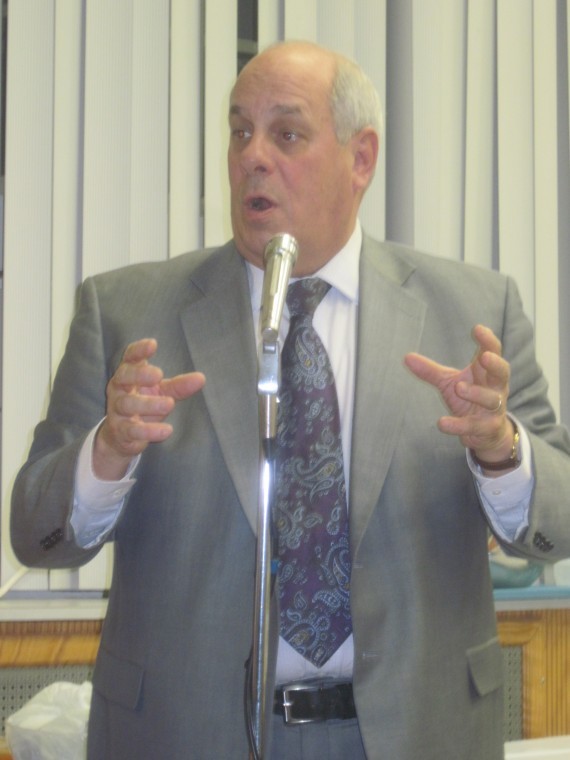Sewanhaka Central High School District officials said at the district’s initial budget workshop on Tuesday night that the proposed 2012-13 budget presented to voters this spring would probably exceed the state-mandated 2 percent tax cap.
“We don’t like to exceed the cap, but that’s where we’re heading,” said Sewanhaka School Board President Jean Fichtl. “If we went to keep our schools whole, we may not be able to meet the 2 percent cap.”
Exceeding the 2 percent tax cap would require a super-majority of 60 percent of district voters coming to the polls in May to pass the budget.
Sewanhaka Superintendent of Schools Ralph Ferrie presented a projected budget of $168.7 million, a 4 percent increase from the current $162.25 million budget.
Ferrie said the budget would maintain all programs and positions in the district. The underlying tax levy to support that budget is projected at $132.65 million, a 4.6 percent increase over the current levy of $126.77 million.
Ferrie presented three different cost-cutting scenarios without indicating specific projected cuts.
The projected tax levy could be reduced to a 3.9 percent increase by reducing the projected budget by $900,000. A 2.9 percent increase in the tax levy would require an additional $1.3 million in budget cuts, Ferrie said. Both of those options would need the 60 percent super-majority to approve them.
Ferrie presented a third option to increase the tax levy by 2.26 percent that would require $3 million in budget cuts. That option would not require a super-majority for passage since the increase factors in property growth in the district and a partial exclusion of pension costs.
“We looked at benefits and risks in terms of different alternatives to get us where we want to be,” Ferrie said.
He said all three scenarios would require serious cuts that remain to be determined by the board. Minimizing the tax levy increase to 2.26 percent would likely result in reductions of teaching staff and academic programs.
“Those cuts are devastating,” Ferrie said. “That’s where we start talking about cutting teachers and programs.”
Sewanhaka’s $162.2 million budget passed last year with 60 percent of the votes, 4,628 to 3,028.
The projected $168.7 million budget includes a 5.3 percent increase in employee salaries, to $97.1 million in 2012-13 from $92.2 million in the current year.
Last year, the Sewanhaka Federation of Teachers waived a 2.9 percent increase for 2011-12 in the final year of its three-year contract for a $2.1 million budget saving.
The Sewanhaka district is anticipating $26.3 million in state education aid, a $774,057 increase from the $25.5 million it received last year, according to Maureen Kenney, Sewanhaka assistant superintendent for business & operations. She said that projection is based on the state aid proposal Gov. Andrew Cuomo presented last month. School district reserves of $3 million also would be included in the budget.
The projected Sewanhaka budget also includes a 7.1 percent increase in employee benefits, to $38.5 million from $35.9 million. Kenney said teachers retirement system costs would increase slightly to 11.84 percent from 11.11 percent and Employee Retirement System costs will rise by 18.5 percent from 15.7 percent this year. She said employee health-care costs would increase by 12 percent
Capital projects in the district’s five schools are projected at $1.1 million, including $40,000 to refinish the gym floor at New Hyde Park Memorial High School, $21,000 to make concrete repairs at the school and $25,000 for replacement of steam traps.
Ferrie said the Sewanhaka district’s average cost per pupil of $17,599 currently ranks 54th among the 57 school districts in Nassau County. He noted that average per pupil cost in the Valley Stream School District is currently $20,281 and the average cost in the Bellmore-Merrick School District is $20,158.
“We’re trying so hard to keep things the way they are. We’re at the bottom. We have nothing left to cut,” Fichtl said.
Kenney said the five-year outlook for the school district budget presents another set of problems. Kenney projected 4 percent increases – the district budget’s average growth rate – over the next five years, and estimated that the district would need to cut $5 million in spending each year to stay within the 2 percent tax cap.
“Finding $5 million in one year would be tough enough. I don’t even know where we would go to at $5 million in the second year,” Kenney said.
Fichtl said the school board would make its next budget presentation at the March 14 meeting. Ferrie said he expected to have a budget outlining prospective cuts for that presentation.
“We don’t want to do any of this, but we don’t have much of a choice,” Fichtl said. “We knew it was going to be ugly. We just didn’t know how ugly it would be.”
Board member David Del Santo said he foresees eventual “draconian” budget cuts because of the “albatross” state legislators had given school districts with the 2 percent tax cap.
“Everything is being looked at. We’re combing this budget to see what we can cut out,” he said.
Del Santo also expressed surprise over the low turnout at the meeting which drew less than a dozen people.
“Is it apathy? Possibly,” he said



